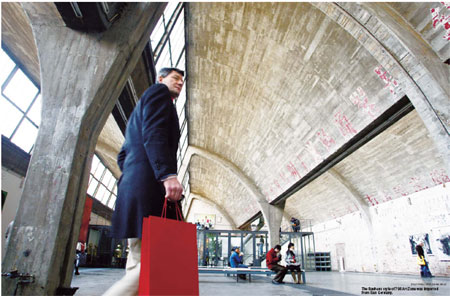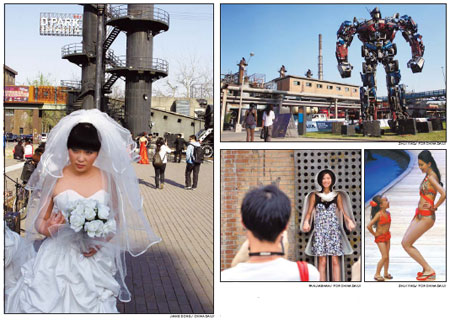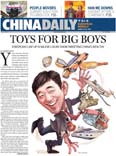Society
In the zone
Updated: 2011-04-21 07:53
By Chen Nan (China Daily)
|
The Bauhaus style of 798 Art Zone was imported from East Germany. Zhui Ying / for China Daily |
|
Clockwise A Transformer statue towers above tourists. 798 is a center for fashion and hosts China International Fashion Week. Amateur photographers have plenty to focus on. 798 has become one of the capital's most popular spots for shooting wedding photos. |
The transformation of 798 Art Zone from a village into an internationally famous center of art reflects the
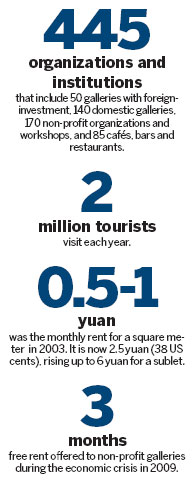 |
Seventy-year-old Shi Wanjiang has witnessed firsthand the startling transformation of what used to be a dusty factory complex 30 years ago into what is now the fashionable and still evolving 798 Art Zone. When Shi and his family first moved into Dashanzi district he wasn't happy, as the former village was tucked away in what was then a distant northeast corner of the capital. But change came quickly and the factories were converted into studios and galleries, to become the epicenter of China's contemporary art scene and a wildly popular tourist destination that now hosts fashion shows, product launches and electronic music festivals.
"I have seen the old housing blocks and factory buildings renovated and coffee shops and Western gourmet restaurants open up all over the district. The character of the area has totally changed," says Shi, who formerly worked at one of the electronics factories supplying the military.
"I take my grandson on walks around 798 Art Zone and to play soccer," Shi says, adding life is much more convenient for him now.
According to the Beijing Administrative Committee of 798 Art Zone, at the end of 2010, there were 445 organizations and institutions in the district. These included 50 galleries with foreign investment, 140 domestic galleries, 170 non-profit organizations and workshops, and 85 cafs, bars and restaurants.
In 2008, Li Kai opened Happy Goat Art Space in 798 to sell animal specimens, pottery and porcelain accessories. The inheritor of his family porcelain business, 23-year-old Li says a niche store like his was a rarity at 798 three years ago, but isn't any longer.
"Rarity makes something valuable. That was why we wanted to open at 798 in the first place," he says.
Li calls 798 "a melting pot of arts" and he's happy to note how it has diversified in recent years, as clothing stores, book stores, photography studios and even a boutique hotel have moved in.
"An art zone shouldn't necessarily focus on highbrow art. I like 798 now because of its dynamic artistic vibes and many different kinds of stores," Li says.
Hao Liran at Vantt Gallery and Caf, which opened in 2008, claims 798 has transformed more than just the arts culture of the capital city.
"The cafe initially catered to foreigners but nowadays many Chinese want a cup of coffee too," Hao says. "It seems to me drinking coffee in the art district has itself has become an art, or an important part of the life of the city."
 |
A typical visitor to this evolving scene is Huang Xiaomi, a Guangzhou-based freelance journalist who says she prefers to stay near the art district, instead of downtown.
"I have lots of friends working and living around the 798 art district, so it's convenient for me to hang out with them. I can also visit the galleries in my spare time," she says.
798 has become a focus of attention around the world partly because the country's contemporary art market has boomed and works by artists such as Zhang Xiaogang and Yue Minjun have sold for tens of millions of dollars.
One of the most high-profile art institutions in 798 is the Ullens Center for Contemporary Art (UCCA), an 8,000-square-meter space that was opened in 2007 by Belgian Baron Guy Ullens, who has collected Chinese art for two decades with his wife.
"For most people in China, art was remote and not understood because there was a paucity of venues and little promotion," says Li Muyi, UCCA's communication director. "The transformation of 798 gives the general public a chance to get close to art."
Li says UCCA is becoming increasingly popular, citing a total of 600,000 visitors since opening, with 350,000 attending in 2010.
"I am happy to see how UCCA has developed and is welcomed by Chinese visitors," says Ullens, who adds that 798 has contributed to the boom in the Chinese contemporary art market. "It's Manhattan's Soho and Greenwich Village, with Chinese characteristics."
Ullens, 76, has good reason to feel confident about the Chinese contemporary art market as the April 3 sale of 100 works from the Guy and Myriam Ullens Foundation Collection - The Nascence of Avant Garde China - at Sotheby's Hong Kong auction, created a record price for Zhang Xiaogang and his work Forever Lasting Love, selling for nearly HK$79 million ($10.16 million).
"Even if 798 chokes on its own success, the art scene in Beijing will remain hot," Ullens comments.
The idea that 798 could become a victim of its own success is echoed by artists such as Huang Rui, who moved to the area 10 years ago and believes its rapid gentrification and commercialization makes it unsuitable for creative artists today.
He was impressed by the area's architecture when he first arrived and rented a house as his studio. "I loved its onion dome and natural sunlight," he recalls. "It was quiet and felt as if it was abandoned, which was just what an artist needed. The character of the area then had a real spirit for creating art. The rents were low and the space vast."
Huang says Sui Jianguo, the former dean of the department of sculpture at the Central Academy of Fine Arts, was one of the first artists to move into the zone, in 2000. He was followed a year later by American Robert Bernell, who set up the Timezone 8 Art Books bookshop and was the first foreigner to move in.
Huang and hutong photographer Xu Yong set up 798 Space Gallery in 2002 and converted a number of other buildings into galleries or studios, but Huang says the essence of the area has changed.
"I feel squeezed walking around here now. The buildings have been turned into flashy stores and tourists are everywhere. An artist needs space to create artworks, but I can't find it here now," he says.
This over commercialization that Huang alludes to is evident in the rising rents and the development of nearby luxury apartments. The change has been met by complaints from artists who say that 798 is becoming more like a theme park than a place to create.
Jin Songmin, 30, has been displaying her woodcut paintings at 798 since 2005 and earned enough money to open her own Song Gallery, in March 2011.
"When I first came to the 798 art district in 2002, there were few galleries. It was hard to even find a place to eat. I remember paying 100 yuan ($15.31) for the second floor of a gallery, which was a mini-restaurant then. There was no menu, just random dishes cooked by the chef," she recalls.
She says there were two types of visitors in those days: Central Academy of Fine Arts students who came to appreciate and learn about art, and collectors who wanted to buy artworks.
"The financial crisis affected the art market and fewer people came here to buy artworks," she says, adding several galleries closed due to the depressed market and rising rents.
"Now, it's more commercial, with more serviced apartments and expensive restaurants, which have attracted more foreigners and young people. But it's losing its real sense of art," she says.
Jin's 120-square-meter gallery is tucked away in a quiet corner of 798, but even so she has to pay rent of more than 600 yuan per day, which is three times what it was 10 years ago.
Brian Wallace founded the first private contemporary gallery in Beijing, in 1991, Red Gate Gallery, which was housed in a Ming Dynasty (1368-1644) watchtower near downtown Chongwenmen.
He says he started organizing exhibitions in 1988 when there were no galleries, no market to speak of, but plenty of good young artists. He opened a branch gallery at 798 in 2005.
"It was a wonderful scene, really just starting off then," Wallace says. "And it made a great contribution to the world of contemporary Chinese art."
He moved out of 798 at the end of 2008 when the financial crisis kicked in and rents priced out small galleries, as the area became more mixed-use and commercialized.
Even so, he says, "If anything, the scene is more mature".
"These changes are to be expected. After all, real estate is real estate. There are still good galleries and good exhibitions if you know where to look."
Cheng Anqi contributed to this story.
E-paper
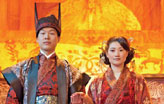
Han me downs
Traditional 3,000-year-old clothes are making a comeback.
Reaching out
Fast growth fuels rise in super rich
Chinese tourists spend more
Specials
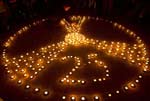
25 years after Chernobyl
Belarus, Ukraine and Russia will mark the 25th anniversary of the nuclear reactor explosion in Chernobyl.
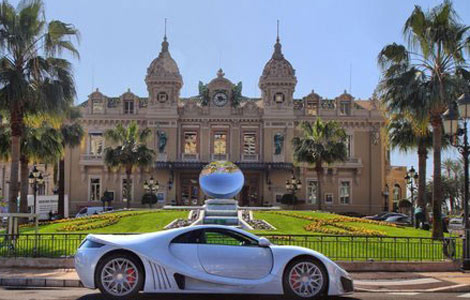
Luxury car show
The world's most prestigious luxury, sports cars and supercars are displayed in Monaco.
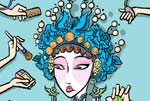
Peking Opera revival
Traditional opera is enjoying a revival in Beijing thanks to some modern touches.
